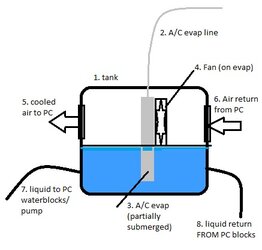- Joined
- Oct 10, 2012
- Location
- Secret lair
Allright,
Technically, this is "advanced watercooling" material; yet, i've decided to post this in "extreme" for two reasons:
1. it involves a modified A/C
2. I didn't want those that think that AIO's are the best thing since sliced bread to go into shock
First of all i have no intention of building this for following reasons:
-i'm lazy
-i don't think it will yield enough to justify the effort
-i don't have enough specialist knowledge on A/C. I know the principle, but don't ask me what is the better refrigerant : R22 , R410 , R134, R1234yf, .. i'ld say that depends on the application. I also know that anything below 12000 BTU is only suited for realy tiny rooms.
-i think that if you want to repurpose an A/C to "a chiller" that you should start with a real ($ 2000,-) split unit and not with those puny "portable" noise emitters or windows units. But thats just me.
Second, i have no intention of building this for the above reasons
Tertio, maybe this has been done before & even in a sticky somewhere. But in that case i haven't found it, or overlooked it. Sorry about that.
So, why this?
The problem with repurposing A/C into subambient PC water chillers is that as soon as you go below dew point, you are looking at condensation issues. The concept -as shown by my 1337 paint skillz- is to dual purpose the violated A/C evap by partially submerging in cooling loop liquid (eg distilled) and partially use as intended to cool some air to be ducted through your PC (and back to the chamber)
NOTES:
yes, there WILL be losses; but the goal of this contraption is to keep condensation at bay, not to go -50 °C
yes, this a rather large setup and you will NOT be able to drag this to a LAN party (who still does lan-parties anyways?)
prerequisites:
-Your PC case must NOT have additional air intakes/exhaust - in fact, you should seal everything off as best as possible and ONLY allow the air ducted from the "chill box" to flow through your PC (and back to the chill box)
-Your waterloop is now an "open" loop, so care must be taken in positioning above or below the chill box
-Your waterloop is now an "open" loop, so your pump must be able to operate in such conditions (backpressure is different vs a closed loop)
-Your waterloop pump must be able handle the 3-6 extra feet of tubing (should not be problem unless you are using a puny AIO pump)
-Your waterloop must cover the "hottest" elements : CPU, GPU(s), VRMs if possible
OPTION:
If you dont want to contaminate or deal with loss of distilled, you can always add a Plate HeatExchanger between PC loop and chill box loop - requires an extra pump thou.
see image below
Legend
1. Tank , container, box , coleman beercooler, "real men" lunchbox (bacon smell included), ......
Assume an insulated box, big enough to hold the A/C evap + 1/4 to 1/2 gallon of liquid
2. A/C evap line
The tube between the evap and the rest of the modified A/C unit
3. A/C Evap
Partially submerged. Purpose: cool the liquid AND cool the air
4. Fan bolted to the evap
Not rocket science
5. Cooled air ducted towards/into the PC case
6. Air returned (ducted) from the PC case
This will be warmer of course, for several reasons, the primary reason air leaks. But it should probably not be as "hot" as you expect as the "worst" offenders are under waterblocks (and your PSU is breathing in from AND venting outside the case). Besides, since the air is recirculated, the cooling should be at par with the warming (or even cooler, if you are lucky)
7. Liquid to PC loop waterblocks/pump
Or to a Plate HX if you want to.
8. Liquid returned from the PC waterblocks/pump
9. a horizontal divider (between air & liquid) to minimise evaporation of the liquid
(not marked on the sketch)
This concept should cool your PC waterloop AND the air moving through your PC, thus keeping condensation at bay should the cooling drop below dewpoint.
Now... the problems:
- I'm not even sure if this will work. I imagine the differential between the submerged & air part of the evap will cause it to have "issues"
- Dimensions: how "big", how "strong" must this contraption be to even dip below ambient? I dunno.
- Efficiency: of course its not
- complexity: yeah, it would be a LOT easier to just use a "normal" big *** A/C and duct some of the cooled air through the PC. But if you compare it to the convoluted "sub-zero" issues & solutions which involve gooping up your MB and such... then this is easier (if it works)
Variant:
A variant which will probably work better : Use TWO A/Cs: One unmodfied to cool the air ducted through the PC; one modified to a waterchiller.
Alright , let me iterate:
-i am NOT going to build this.
-This is more an excercise, a feasability study.
-I am well aware this might not work at all or not yield anything more as mediocre results.
-The goal is a contraption to keep possible condensation issues at bay.
-it is very well possible this has been tried before.
But anyways... Comments? Remarks? Calculations? Pointers/links to "done before". Discuss
Please try to keep kindergarten comments like "me 1337 CoolIt/H60 will pwn yer *ss" out of it
.
